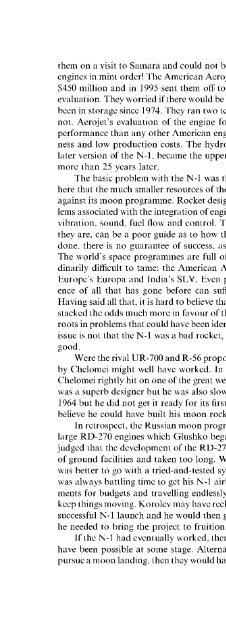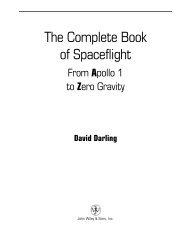Soviet and Russian Lunar Exploration
Soviet and Russian Lunar Exploration
Soviet and Russian Lunar Exploration
You also want an ePaper? Increase the reach of your titles
YUMPU automatically turns print PDFs into web optimized ePapers that Google loves.
them on a visit to Samara <strong>and</strong> could not believe their eyes: hundreds of moon rocket<br />
engines in mint order! The American Aerojet company at once bought 90 of them for<br />
$450 million <strong>and</strong> in 1995 sent them off to its Sacramento, CA plant for testing <strong>and</strong><br />
evaluation. They worried if there would be any problems in relighting motors that had<br />
been in storage since 1974. They ran two tests - of 40 sec <strong>and</strong> 200 sec - <strong>and</strong> there were<br />
not. Aerojet's evaluation of the engine found that it could deliver over 10% more<br />
performance than any other American engine <strong>and</strong> enthused over its simplicity, lightness<br />
<strong>and</strong> low production costs. The hydrogen upper stage, originally planned for a<br />
later version of the N-1, became the upper stage of the Indian GSLV launch vehicle<br />
more than 25 years later.<br />
The basic problem with the N-1 was the lack of thorough ground-testing. It was<br />
here that the much smaller resources of the <strong>Soviet</strong> Union <strong>and</strong> poor organization told<br />
against its moon programme. Rocket designers continued to underestimate the problems<br />
associated with the integration of engines on stages <strong>and</strong> the resulting problems of<br />
vibration, sound, fuel flow <strong>and</strong> control. Testing engines individually, however good<br />
they are, can be a poor guide as to how they behave collectively. Even where this is<br />
done, there is no guarantee of success, as the thoroughly prepared Proton proved.<br />
The world's space programmes are full of histories of rockets that proved extraordinarily<br />
difficult to tame: the American Atlas <strong>and</strong> Centaur, the Chinese Feng Bao,<br />
Europe's Europa <strong>and</strong> India's SLV. Even programmes that have built on the experience<br />
of all that has gone before can suffer nasty surprises, like Europe's Ariane.<br />
Having said all that, it is hard to believe that thorough ground-testing would not have<br />
stacked the odds much more in favour of the N-1. The four flight failures all had their<br />
roots in problems that could have been identified in thorough ground-testing. The real<br />
issue is not that the N-1 was a bad rocket, but that the Saturn V was so exceptionally<br />
good.<br />
Were the rival UR-700 <strong>and</strong> R-56 proposals better? The UR-700 scheme developed<br />
by Chelomei might well have worked. In promising exhaustive ground-testing first,<br />
Chelomei rightly hit on one of the great weaknesses of Korolev's approach. Chelomei<br />
was a superb designer but he was also slow: his Almaz space station was approved in<br />
1964 but he did not get it ready for its first flight until 1973 <strong>and</strong> there is no reason to<br />
believe he could have built his moon rocket any sooner.<br />
In retrospect, the <strong>Russian</strong> moon programme might have been better to go for the<br />
large RD-270 engines which Glushko began to develop. Korolev probably correctly<br />
judged that the development of the RD-270s would have required an extensive range<br />
of ground facilities <strong>and</strong> taken too long. With time against him, he calculated that it<br />
was better to go with a tried-<strong>and</strong>-tested system, even if it meant 30 engines. Korolev<br />
was always battling time to get his N-1 airborne, struggling with government departments<br />
for budgets <strong>and</strong> travelling endlessly to Samara, Leningrad <strong>and</strong> Baikonour to<br />
keep things moving. Korolev may have reckoned that he had to be lucky with only one<br />
successful N-1 launch <strong>and</strong> he would then get, from the political bosses, the resources<br />
he needed to bring the project to fruition.<br />
If the N-1 had eventually worked, then a <strong>Russian</strong> moon l<strong>and</strong>ing would definitely<br />
have been possible at some stage. Alternatively, if the <strong>Russian</strong>s had decided not to<br />
pursue a moon l<strong>and</strong>ing, then they would have had available to them a large rocket able







